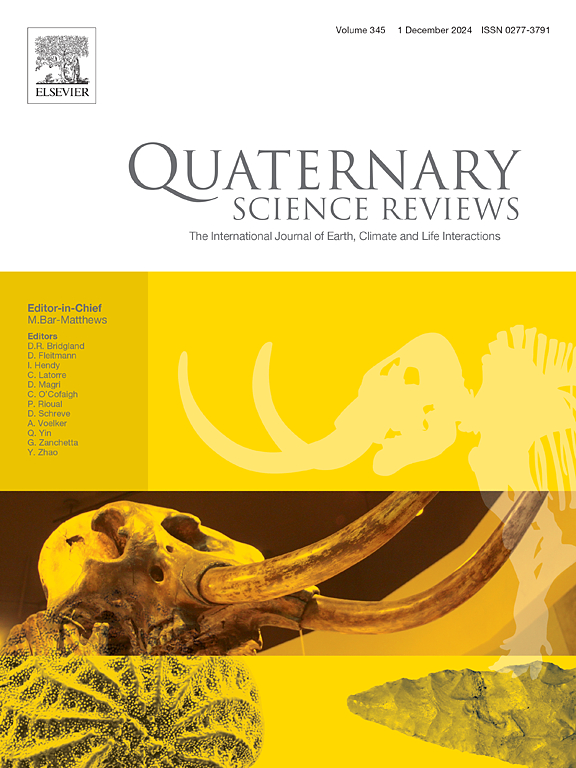Formation conditions of coastal palaeolakes and associated abiotic aragonite deposition in the eastern Mediterranean during the upper Pleistocene
IF 3.2
1区 地球科学
Q1 GEOGRAPHY, PHYSICAL
引用次数: 0
Abstract
During the Last Glacial Period (LGP), when sea level was up to ∼130 m lower than today, many of the currently semi-enclosed gulfs in the Eastern Mediterranean were isolated from the open sea, functioning as palaeolakes. This was the case for the western Saronikos Gulf in Greece, which was isolated from the Aegean Sea. The palaeogeographic evolution of this area was investigated by analyzing a 350 cm sediment core for grain size, inorganic geochemistry, mineralogy, and bulk δ13C and δ18O compositions. An age model was developed by combining radiocarbon (14C) and uranium-thorium (U/Th) dating methods. Integrating all available data and accounting for eustatic sea-level fluctuations, the sedimentary units of core SARC-18 cover the last glacial-interglacial cycle, spanning from 44.5 kyr BP to the present.
Two marine sedimentation intervals were identified, characterized by clay minerals, biogenic calcite, and light δ13C and δ18O isotopic signatures. These intervals are separated by a lacustrine sedimentation phase, marked by the exclusive deposition of authigenic aragonite and a significant enrichment in δ13C and δ18O. The latter elevated δ13C and δ18O values suggest carbonate mineral formation in an evaporative and saline environment under low temperatures (5–10 °C). Sedimentation rates during the marine intervals range from 5.8 to 6.0 cm kyr⁻1, and are more than double during the lacustrine interval (11.9–14.0 cm kyr⁻1) due to the extensive deposition of authigenic aragonite.
上更新世地中海东部沿海古湖泊形成条件及伴生文石沉积
在末次冰期(LGP),海平面比现在低约130米,东地中海目前的许多半封闭海湾与公海隔绝,起着古湖泊的作用。希腊西部的萨罗尼科斯湾就是这种情况,它与爱琴海隔绝。通过对350 cm沉积物岩心粒度、无机地球化学、矿物学、体δ13C和δ18O组成的分析,探讨了该区的古地理演化。结合放射性碳(14C)和铀钍(U/Th)测年方法建立了年龄模型。综合所有可用数据并考虑海平面上升波动,SARC-18岩心的沉积单元覆盖了从44.5 kyr BP到现在的末次冰期-间冰期旋回。确定了2个海相沉积层段,具有粘土矿物、生物方解石、轻δ13C和δ18O同位素特征。这些层段被一个湖相沉积阶段隔开,其特征是自生文石的完全沉积,δ13C和δ18O显著富集。后者δ13C和δ18O值的升高表明碳酸盐矿物形成于低温(5 ~ 10℃)蒸发和盐环境。海相阶段的沉积速率为5.8 - 6.0 cm kr - 1,而在湖相阶段(11.9-14.0 cm kr - 1),由于自生文石的大量沉积,沉积速率增加了一倍多。
本文章由计算机程序翻译,如有差异,请以英文原文为准。
求助全文
约1分钟内获得全文
求助全文
来源期刊

Quaternary Science Reviews
地学-地球科学综合
CiteScore
7.50
自引率
15.00%
发文量
388
审稿时长
3 months
期刊介绍:
Quaternary Science Reviews caters for all aspects of Quaternary science, and includes, for example, geology, geomorphology, geography, archaeology, soil science, palaeobotany, palaeontology, palaeoclimatology and the full range of applicable dating methods. The dividing line between what constitutes the review paper and one which contains new original data is not easy to establish, so QSR also publishes papers with new data especially if these perform a review function. All the Quaternary sciences are changing rapidly and subject to re-evaluation as the pace of discovery quickens; thus the diverse but comprehensive role of Quaternary Science Reviews keeps readers abreast of the wider issues relating to new developments in the field.
 求助内容:
求助内容: 应助结果提醒方式:
应助结果提醒方式:


